“Time is a construction material,” says 64-year-old architect Emilio Tuñón Álvarez as we stand at the threshold to Madrid’s new Galería de las Coleccionnes Reales (Royal Collections Gallery, or GCR). And he should know: almost a quarter century after his then firm, the globally renowned Mansilla + Tuñón, entered the first competition to design the institution, the $165 million building finally opened to the public this June. A lot has happened since, including the 2012 heart attack that struck down his former partner, Luis Moreno García Mansilla, at the age of just 53. “His death was a disaster, but what could we do?” asks Tuñón, now principal at Tuñon y Albornoz Arquitectos, alongside Carlos Martínez de Albornoz. “We carried on. This is Luis’s final building.”
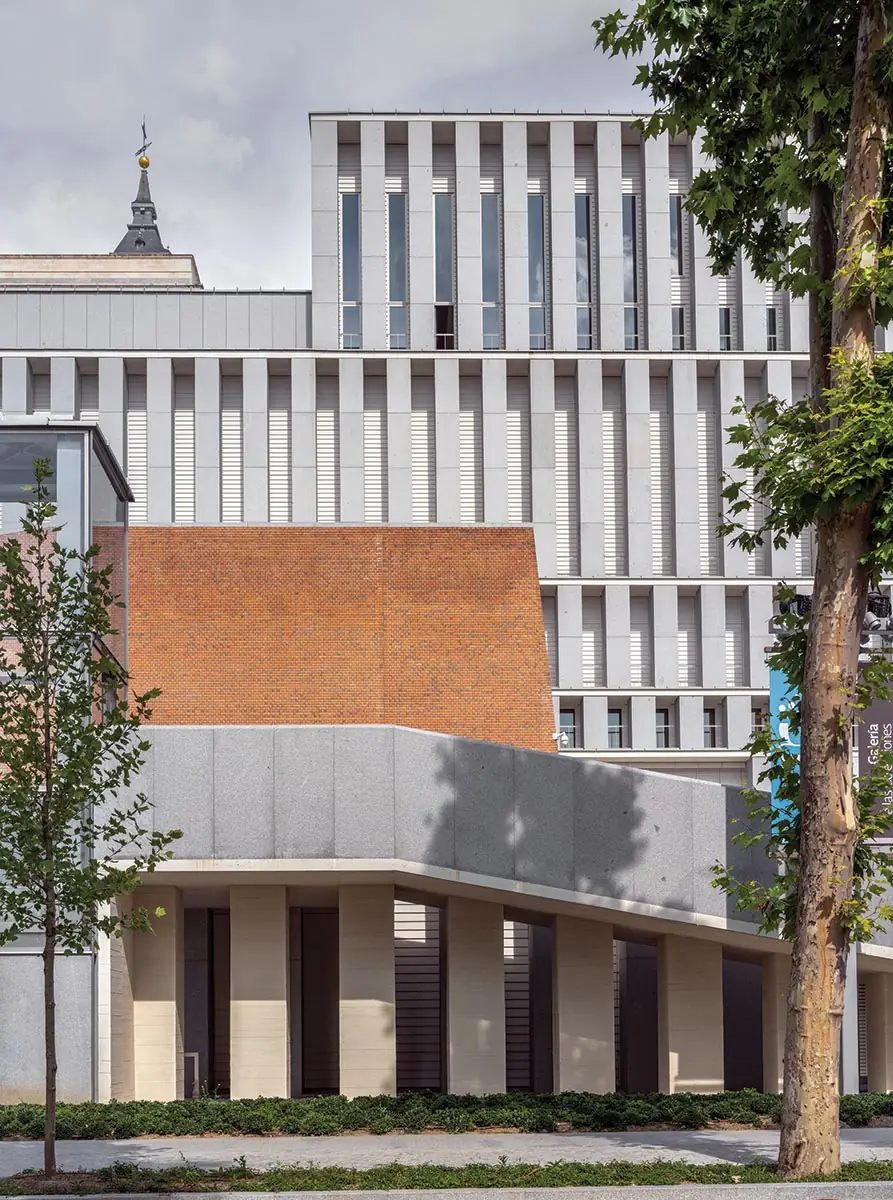
From below, the Royal Collections Gallery reads as a complex stack of floors of varying heights. Photo © Luis Asín, click to enlarge.
As sites go, it’s difficult to find one that’s more dramatic or prestigious—on the crest of a forbidding promontory right next to Madrid’s vast Palacio Real (Juvarra, Sacchetti, Sabatini, et al., 1735–1905), with spectacular views over the Casa de Campo (a former royal hunting park), the forest of El Pardo, and the peaks of the Sierra de Guadarrama beyond. “This was the founding point of Madrid,” says Tuñón of the spot where the ninth-century alcazaba once stood, a citadel built to defend Muslim Toledo from the Christian kingdoms to the north. “The Galería completes the line of the city’s crest.” What’s more, with artworks by Bernini, Rubens, Titian, and Velázquez, not to mention furniture, fans, carriages, and a pair of armored Mercedeses gifted to Franco by Hitler, the collections are just as spectacular and challenging as the site.
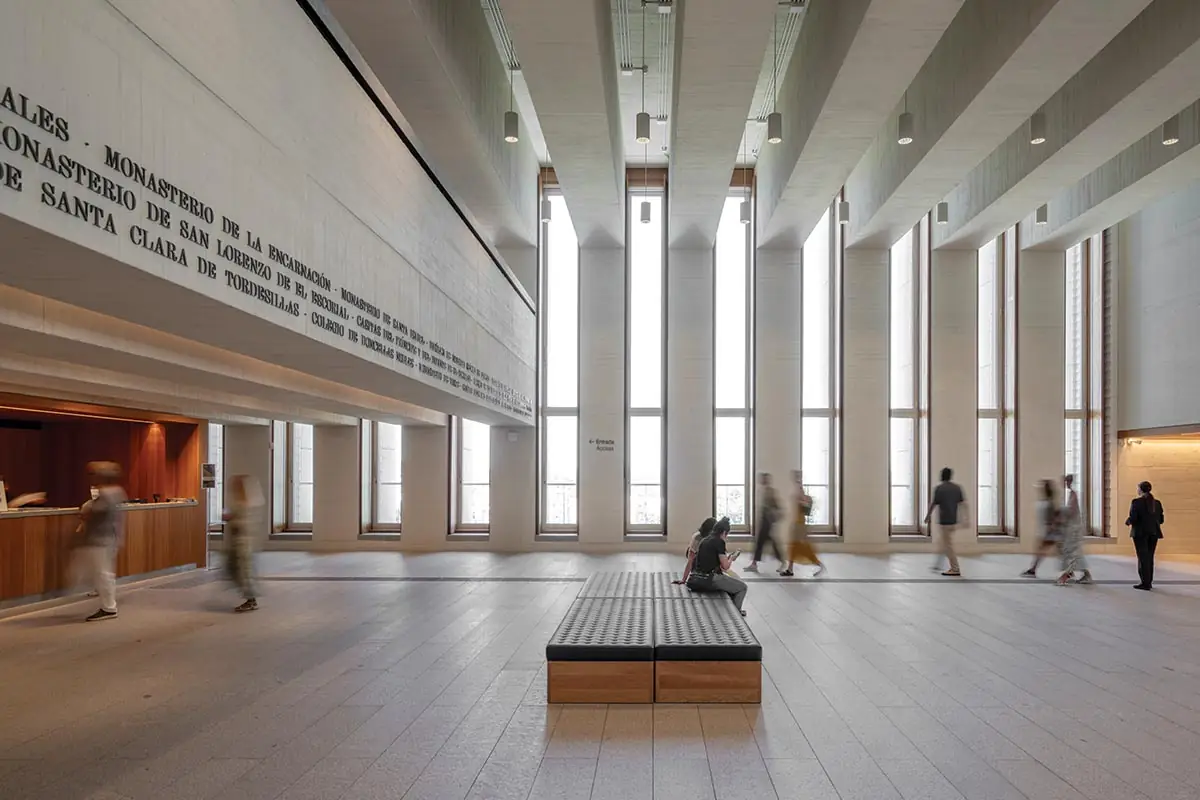
The lobby’s stately columns frame views of the landscape. Photo © Luis Asín
The idea of building a museum for the royal collections dates back to Spain’s Second Republic (1931–39), which, after Alfonso XIII’s flight into exile, nationalized the monarch’s palaces, monasteries, and gardens and founded Patrimonio Nacional to oversee them. Seven decades later, at the turn of the millennium, the Spanish government finally launched the project as part of a wider program of museum expansion in Madrid: Rafael Moneo won the commission to extend the Prado in 1998, Jean Nouvel scooped up the Reina Sofía enlargement in 1999, while BOPBAA was victorious in the 2000 Thyssen-Bornemisza remodeling contest. For the GCR, viewed at the time as an extension to the Palacio Real, the 1999 competition asked seven finalists to slot their designs into an L-shaped site wrapping one corner of the huge and unloved Catedral de la Almudena (1883–1993), next to the palace’s parade ground, the Plaza de la Armería. Spanish firm Estudio Cano Lasso won the job, beating not only David Chipperfield and Zaha Hadid but also Mansilla + Tuñón, who were disqualified for disrespecting the site boundaries—to avoid building between the palace and the cathedral, the duo eschewed the competition’s L contours, proposing instead to occupy the whole strip of land along the edge of the ridge, whose southernmost tip belonged to the church and not to Patrimonio Nacional.
The story would have ended there for Mansilla + Tuñón were it not for Antonio Vázquez de Castro Sarmiento, a respected Spanish architect who had worked on the Reina Sofía conversion. As Tuñón tells it, furious at having been overlooked in the extension competitions, he attacked the GCR results in court on a technicality: children of the illustrious Julio Cano Lasso (1920–96), the winners, had submitted their father’s résumé to get through the selection process. After the court found in Vázquez de Castro’s favor, the authorities organized a new competition in 2002, to which Mansilla + Tuñón submitted exactly the same project—and this time won.
Motivated by the presence of important archeological remains, the duo’s decision not to build between the cathedral and the palace is among the more brilliant aspects of their scheme: as you approach the GCR from the cathedral plaza, the 538,000-square-foot building is entirely invisible, since it dips down to form a belvedere from which to admire the extraordinary view. To your right is one wing of the palace, to your left the extremely discreet entrance, and in front of you the 100-foot drop to the Campo del Moro, the palace’s gardens below. Viewed from down there, the GCR reveals itself as a complex piling up of floor plates of different depths, with auxiliary program in the larger lower levels, which, projecting farther into the Campo del Moro, form a podium for the galleries and other public areas in the five slimmer stories above. While the bottom floors, with their brick-clad ramps, are massed to fit in with Sabatini’s brick-and-stone palace basement, the public spaces are encased behind a formal grill of offset orthogonal colonnades, intended to echo the solemn march of Sacchetti’s granite-and-limestone facades. This is perhaps the GCR’s one false note, for, although contextually faced in huge blocks of granite 1 foot thick and up to 10 feet high (in all, 353,000 cubic feet of stone, says Tuñón, snapped up for nothing in the wake of the financial crash), these brooding elevations, with their fortress-like balistraria, appear a little cumbersome next to the palace’s stately Italian baroque.
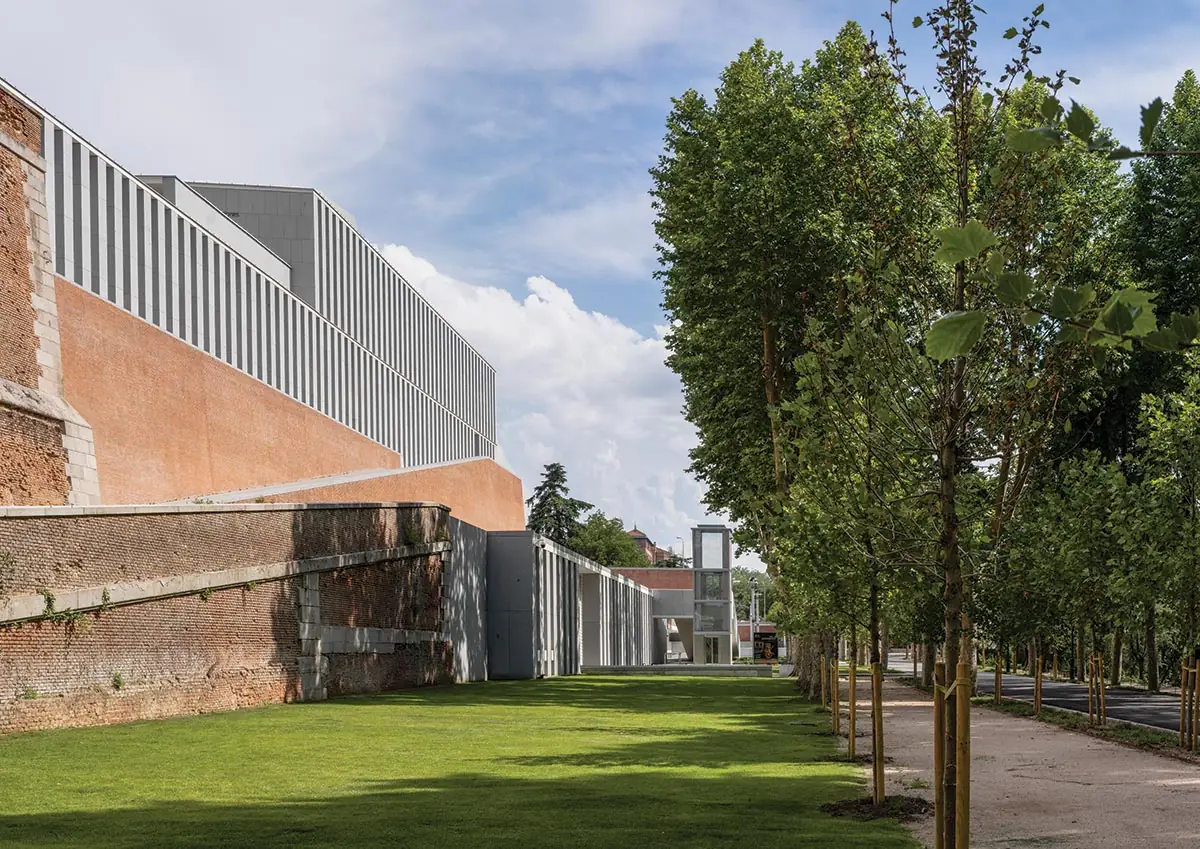
1
The lower floors’ ramps are brick, like the walls of the adjacent palace basement (1), while the rest of the building is enclosed in offset stone colonnades (2). Visitors descend through the museum via an internal ramp (3). Photos © Luis Asín
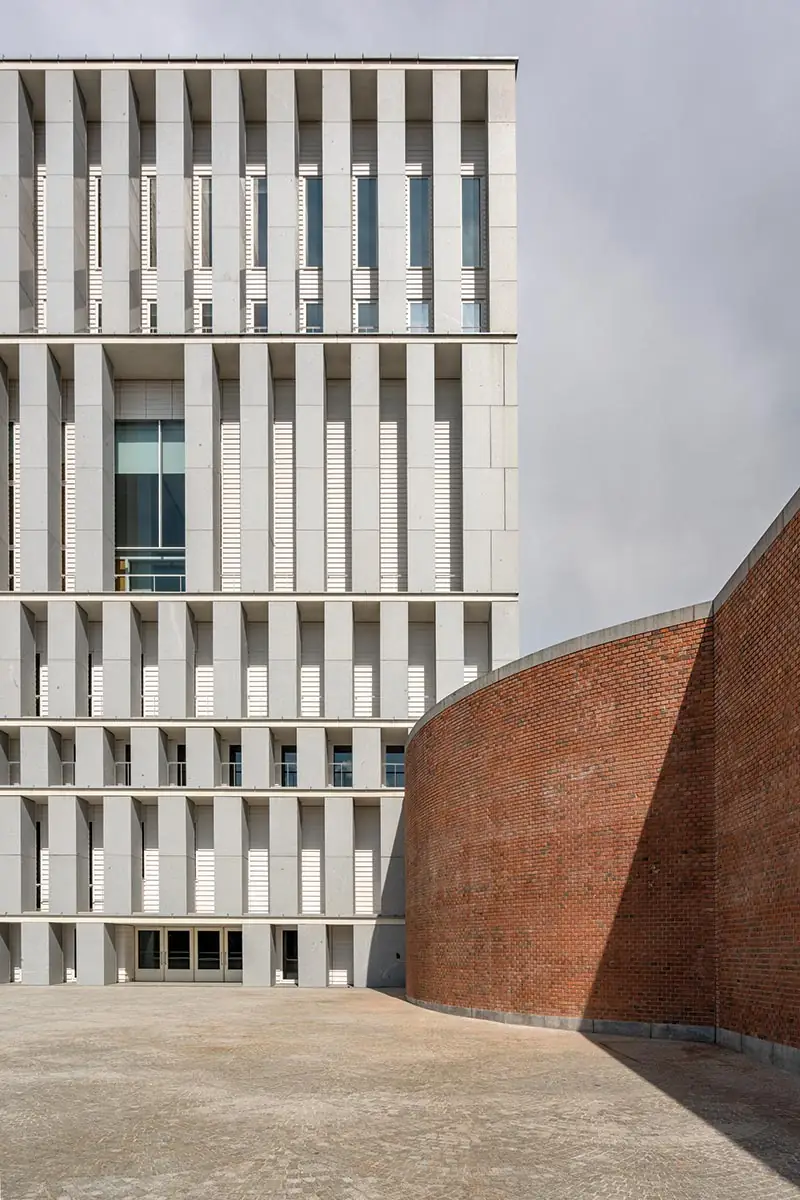
2
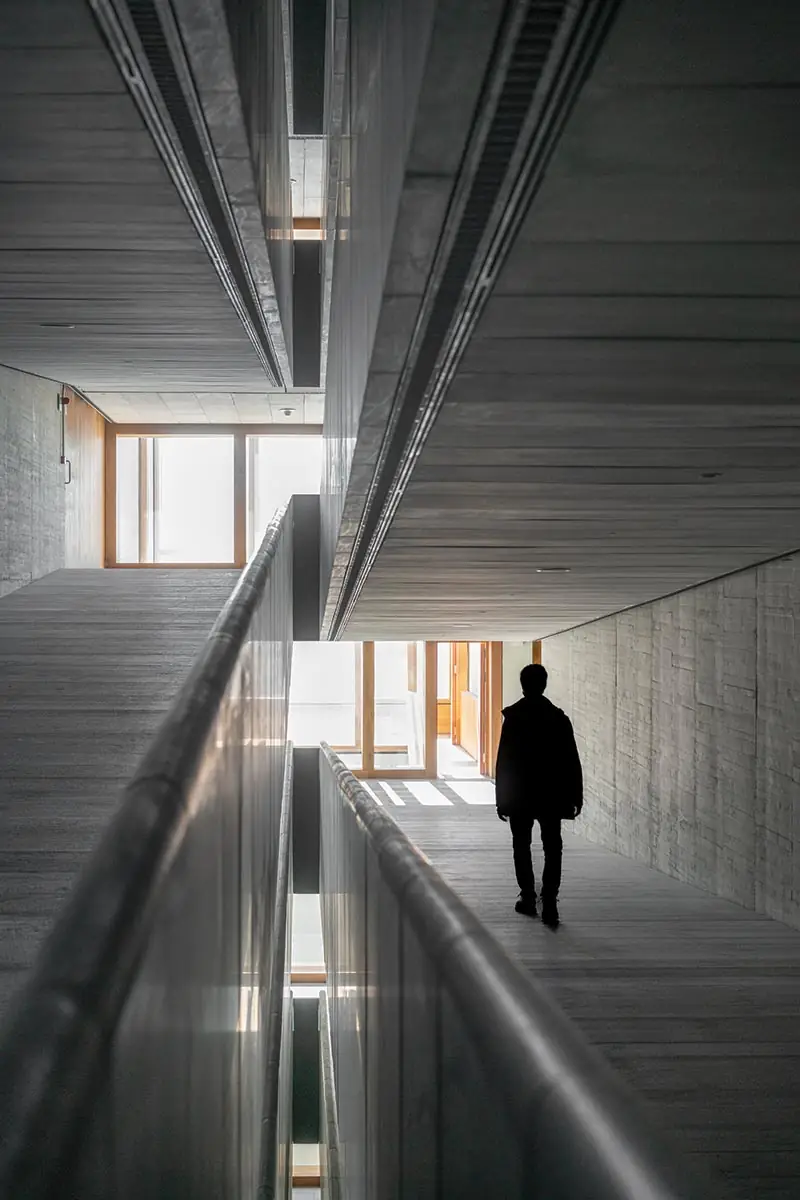
3
There is, of course, a reason for this massiveness. Besides providing a retaining wall for the promontory flank, the GCR houses three giant galleries, 338 feet long and 53 feet wide, stacked one on top of the other. Realized in heavily reinforced concrete whose white-limestone aggregate matches the palace facades, their structure takes the form of tightly cadenced, endlessly repeating orthogonal frames that enclose spaces free from intermediary supports. “The building is like a piece of freeway infrastructure,” says Tuñón. “You could drive trucks inside it.” At the time of the competition, the idea was to divide the collections by object type: the 26-foot-high upper gallery would display tapestries, the 18-foot-high middle space the fine and decorative arts, while the 20-foot-tall lower gallery would showcase the carriage collection. Visitors would enter from the top and descend via a series of monumental ramps, after which a giant elevator (capacity 140) would bring them back up and out again.
The competition fiasco was just the first of many factors that pushed the timeline over the two-decade mark. The detailed-design phase took three years to complete after Patrimonio Nacional decided the GCR needed to operate independently of the Palacio Real and asked Mansilla + Tuñón to add in an auditorium and a cafeteria. When construction finally began, in 2006, lengthy archaeological digs—among them the former palace gasworks, whose heavy contamination needed cleaning up—and the 2008 financial crash saw to it that the building would not be completed until late 2015. Then began what El País has described as an eight-year-long “political-diplomatic-cultural psychodrama” involving “four prime ministers, five presidents of Patrimonio Nacional, two directors of the GCR, an ex-king, and all the political and administrative apathy in the world.” Part of that drama was triggered by the first director, José Luis Díez, who quite legitimately questioned the logic of organizing the collections typologically. After prolonged debate, the inaugural display, as curated by his successor, Leticia Ruiz Gómez, mixes everything up to tell the story chronologically: in the upper gallery, we find the royal houses of Trastárama and Austria (with objects from the reigns of Isabella of Castile to Charles II, 1474–1700); in the middle space, the Bourbons, the current ruling dynasty (with displays covering Philip V to Alfonso XIII, 1700–1931); while the lowest level has been split in two, with temporary exhibitions in one half—cars and carriages for the inaugural show—and a secondary entrance (essentially for groups) in the other.
The vast majority of visitors will arrive from above, as initially intended, through an entrance that Tuñón describes as “a bit of a joke. It’s something we learned from [former employer] Rafael Moneo, who used to say, ‘Good buildings are small outside and large inside.’” To this end, in a classic architectural trick, the scheme has you pass through a low, dark space before emerging into a high, light-filled entrance hall that sets the tone for what’s to come, with its beautifully cast, board-marked white-concrete columns and beams framing views out onto the landscape beyond. “We sought to mix the monumental and the domestic,” says Tuñón about details such as white-lacquered louvers and oak window shutters that recall the vocabulary of the Palacio Real. After traversing the upstairs gift shop, you arrive at the impressive ramp, part Villa Savoye and part Renaissance stairway (think the Louvre’s Escalier Henri II), with granite floors and handrails that evoke the Escorial (1563–84), Philip II’s vast and gloomy palace-monastery in the foothills of the sierra.
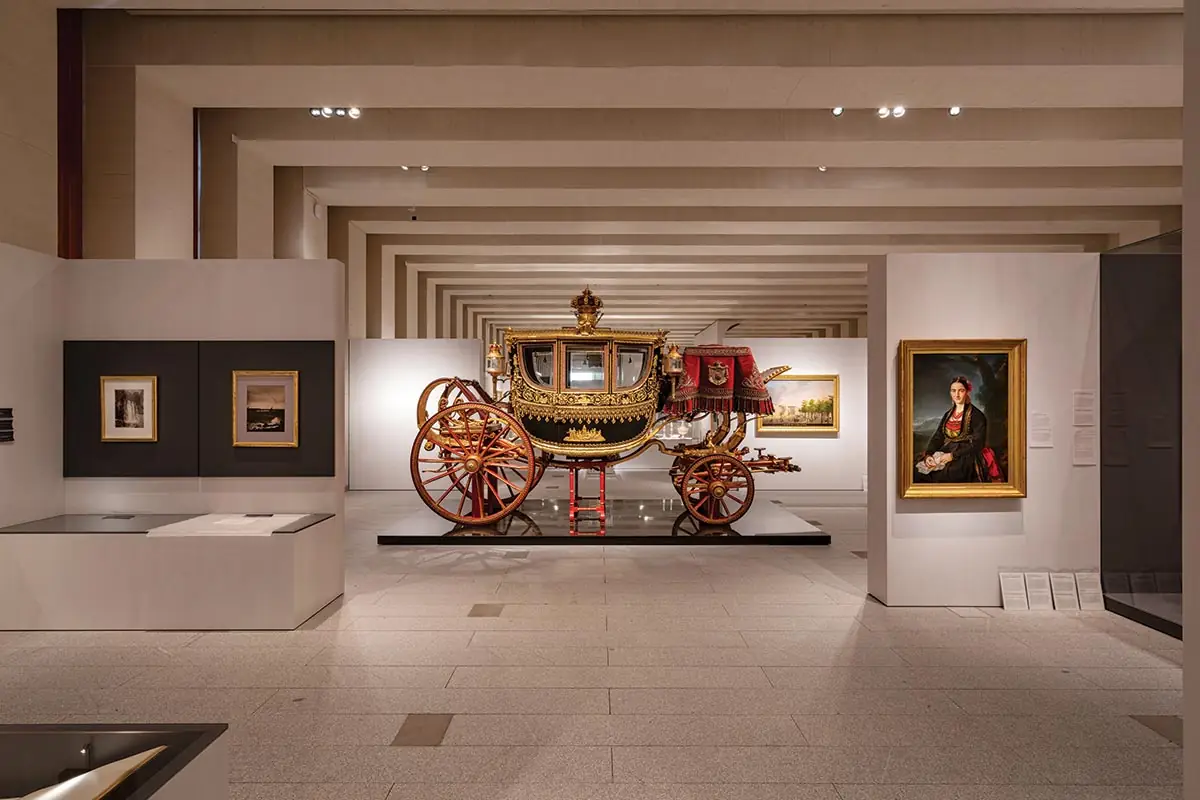
7
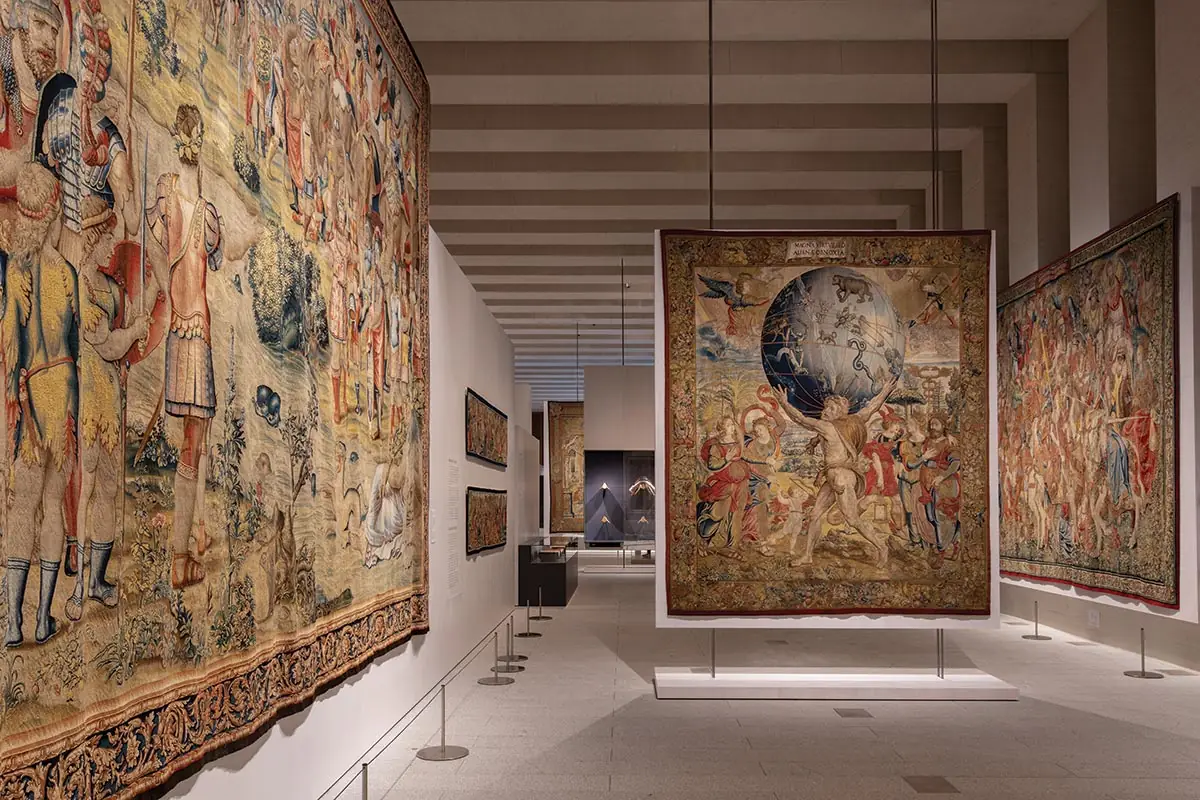
8
The repeating concrete frames help organize lighting and conceal mechanical equipment in the galleries (7 - 9). Photos © Luis Asín
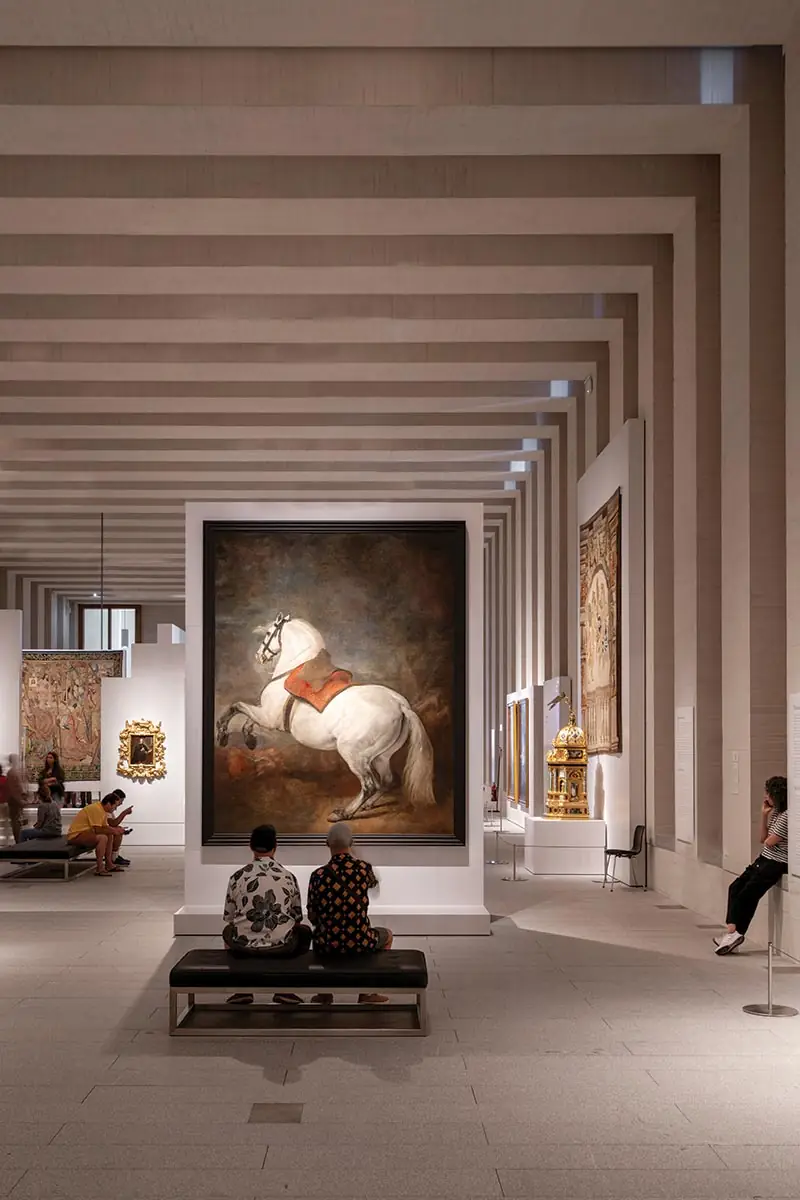
9
Until the GCR opened, many of the 170,000 pieces in the royal collections were hidden from view in the Palacio Real’s basement. For the inaugural hang, 650 are showcased in a finely detailed display designed by architect Manuel Blanco (notably, with curved supports that allow big 18th-century tapestries to be hung in the Bourbon gallery, whose ceiling is a little too low for them). As well as providing a monumental yet neutral setting for all the gilt and pomp, Mansilla + Tuñón’s repeating concrete frames recall the heavy wood beams of Renaissance ceilings, and allow lighting and other equipment to be hidden between them. Moreover, the GCR furthers understanding of Madrid’s early history, with remains of the Hispano-Moorish citadel revealed on level -1. A deceptively simple project, where structure and envelope appear to become one and the same, this rich, layered, deftly handled building was thoroughly worth the wait.
Click drawing to enlarge
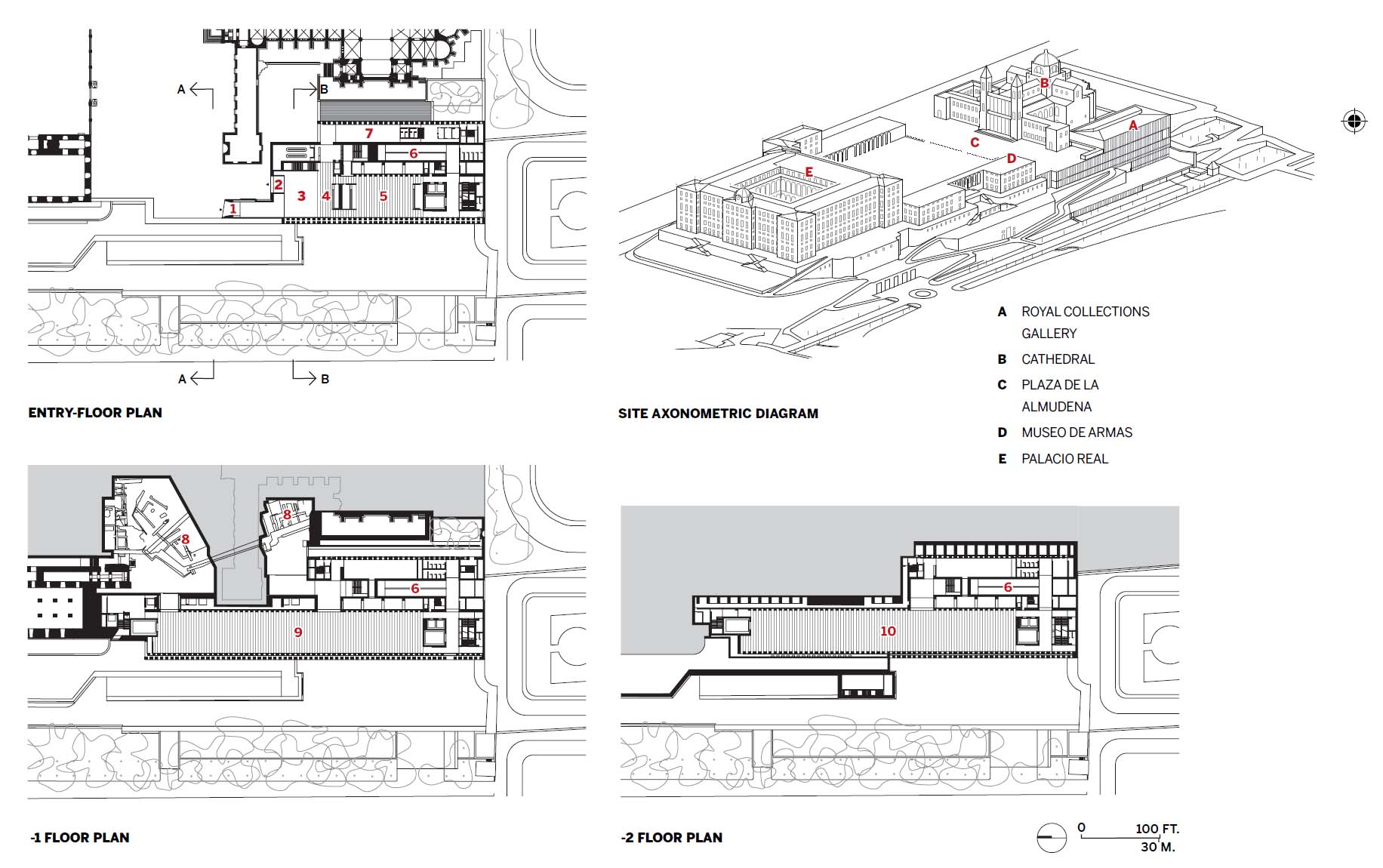
Click drawing to enlarge
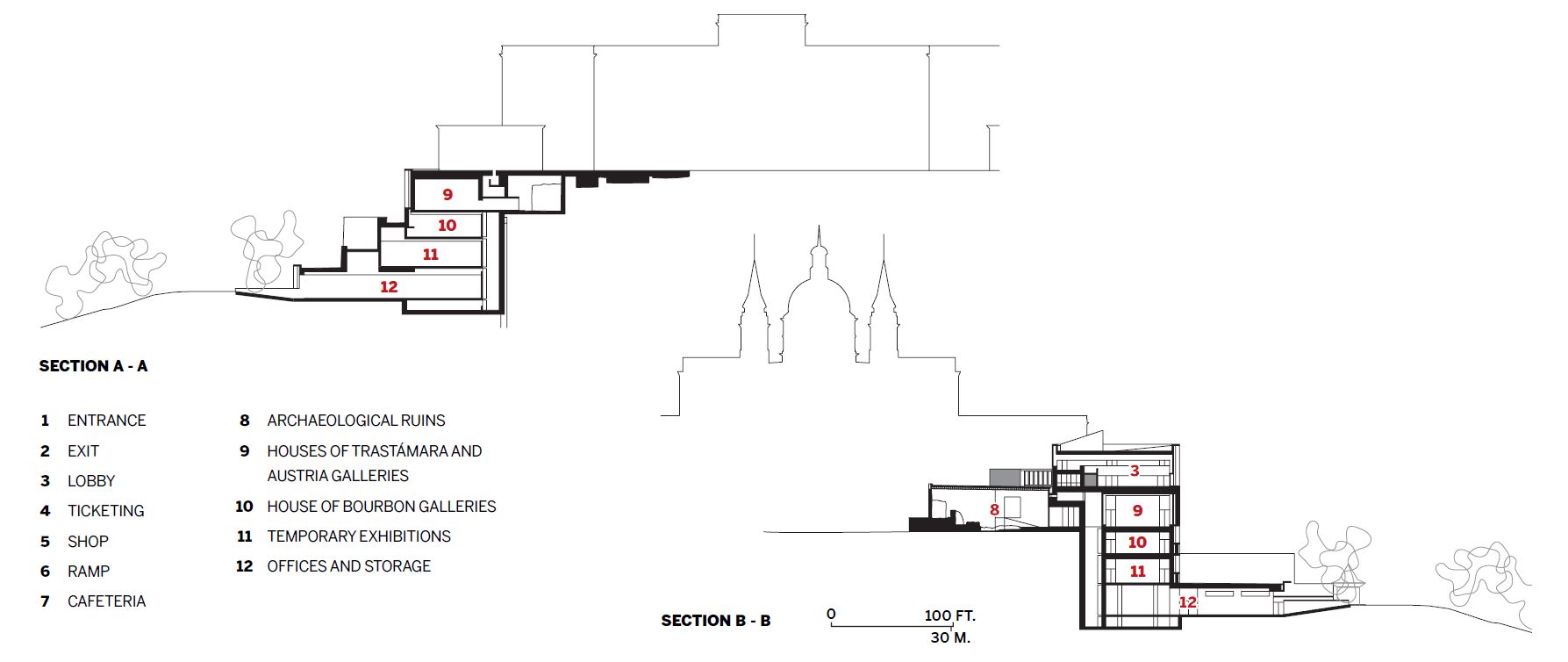
Credits
Architect:
Mansilla + Tuñón Arquitectos — Luis Moreno García Mansilla, Emilio Tuñón Álvarez, Carlos Brage, Rubén Arend, Matilde Peralta, Andrés Regueiro, Clara Moneo, Teresa Cruz, Bárbara Silva, Jaime Gimeno, Stefania Previati, David Nadal, Oscar F. Aguayo, Carlos Martinez de Albornoz, Asa Nakano, Coco Castillón, Javier González Galán, Mila Moskalenko, Inés García de Paredes
Engineers:
J.G. Asociados (m/e/p); GOGAITE Ingenieros (civil)
Consultants:
Manuel Blanco Lage, Hector Navarro (museography)
General Contractor:
FCC Fomento de Construcciones y Contratas
Client:
Patrimonio Nacional
Size:
538,000 square feet
Cost:
$165 million
Completion Date:
June 2023
Sources
Glazing:
Saint-Gobain
Curtain Wall:
Jansen
Stone:
Granilouro
Roofing:
BASF
Vertical Circulation:
TK Elevator
Lighting:
ERCO



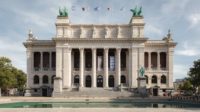
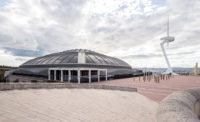
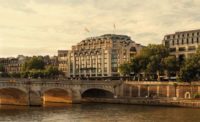
Post a comment to this article
Report Abusive Comment